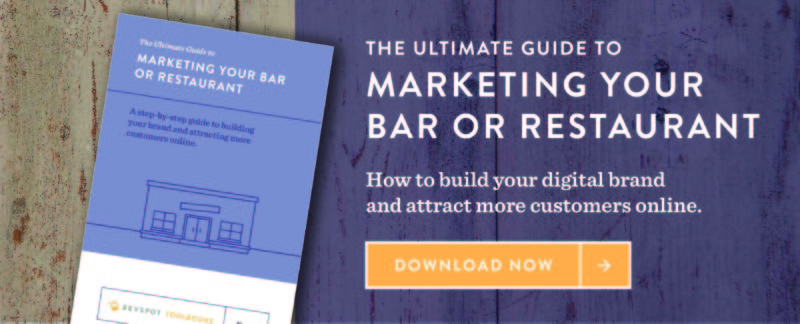

As a business tool, email marketing is more powerful than ever. And not just for the big companies—for businesses of any size, in any industry. Email drives the highest ROI (return on investment) of all marketing channels, and with the explosion of innovative marketing technology, it’s now easy for bar and restaurant owners with no marketing experience to boost sales through powerful marketing campaigns.
For a restaurant or bar, email marketing is one of the cheapest and easiest ways to engage with and build loyalty among your customers. You know your customers best, so be sure to use language and design that reflects your brand and resonates with the reader. If your average customer is a young, hip millennial, try using fun language and cultural references they will appreciate. If your average customer is a craft beer junkie, you’ll want to show your expertise and knowledge of industry trends.
And don’t worry—if you are just getting started with email marketing for your business, you’re still ahead of the game. Most bars and restaurants are not currently using email to communicate with their customers, other than the occasional reservation confirmation. But getting ahead, when it comes to marketing your bar in creative ways, can mean huge increases in customer loyalty, word of mouth, public relations, awareness and, of course, sales.
Now, let’s do this!
Selecting and setting up email software might feel premature before even having an email list, but it’s important to understand the functionality of the tool you select before building out your email strategy. If you are just starting your email program, Mailchimp offers a free plan for lists under 2,000 subscribers. Campaign Monitor and Express Pigeon are also good options for smaller bars and restaurants, with a focus on email design.
Most email tools will provide at least a few basic email templates for their users. If you’re just getting started and don’t happen to have a friend with email design and coding skills, I’d recommend using the templates within your chosen email tool. They’re usually clean, tested designs that have been optimized for mobile—meaning the text is large enough to read on a mobile device, the calls-to-action buttons are an optimal size for clicking with your thumb, and images scale to fit on a smaller screen. About 60% of email opens are on a mobile device these days, and this number will continue to increase over time. It’s important to keep this in mind when choosing your email design.
Once you have chosen an email template that best suits your brand, the first email you’ll want to create is a welcome email to anyone who subscribes to your list. It’s important to set the voice of your brand in this first welcome email. This is your only chance to make a good first impression on their inbox, so I’d recommend including the following:
Once you’ve created your first email, the rest will come easy! Try to keep designs for specific types of emails consistent so that your customers can easily distinguish an event invite from a holiday closing notification.
You can’t have an email program with nobody to email! You might be wondering why collecting customer emails wasn’t the first step in starting your email program. When customers provide their email, they do so because they want to hear from you, and relatively quickly. It takes time to choose an email software platform and create branded email templates. If they don’t hear from you until months after they’ve signed up for your program, it will feel random and impersonal, and you unsubscribe rates will reflect that.
The easiest way to get started with collecting email addresses is by asking for them in-house. This can be as simple as setting up a fishbowl to collect business cards in an accessible place in your bar, or asking them to write it on their check if they enjoyed their experience. I’d recommend adding an incentive, such as a chance to win a gift card to your bar or restaurant, to encourage customers to give you their email.
You will also need to collect emails online in order to scale your list. Be sure to keep your email opt-in field visible in the header and footer of your website. Some advanced POS and payment systems also have the ability to collect email and additional customer data. Another option is to collect emails on your social channels, but don’t forget to provide that incentive. Give customers a reason to give you access to their already-overflowing inbox.
The one piece of advice you’ll hear over and over again when creating an email program is to test, test, test. Think about your own inbox and how cluttered it can be; make sure you’re standing out to your customers. Once you have a sizeable email list, you’ll want to test subject lines, email designs, CTAs (calls-to-action), promotions, and even the time of day that you are sending. As you test, be sure to keep track of all successes and failures—and only test one variable at a time. Did you have a higher unsubscribe rate when you pushed a promotion? Were your open rates lower on the weekend than during the week? This will allow you to optimize your email program over time and learn how to get the right content to your customers at the right time.
Email is a great way to stay in touch with your customers in a more personal way, and it’s a great tool to use to incorporate other marketing channels and expand the reach of your business. Try including an invitation to follow your bar or restaurant on your social channels in the footer of your emails. Send exclusive invites or offers to customers that will encourage them to stay engaged with your email program, and be sure to thank your customers whenever it’s appropriate—it shouldn’t be all about selling. Sometimes, a “Thanks for being a great customer—Happy Holidays!” email is enough to turn an occasional customer into a loyal one.
While email design and code is constantly changing to adapt to new devices and audiences, email itself isn’t going anywhere. Businesses of all sizes have had great success in building customer loyalty, increasing sales, and boosting overall business reach and legitimacy through email marketing campaigns.
The bar and restaurant industry is a risky business to be in. Take your bar to the next level and extend that sense of hospitality even further, right into your customer’s inbox. Kickstart your marketing efforts with a brand new email program.
Want to learn more? Find out how to advertise your bar or restaurant online, on sites like Google, Facebook and Instagram.
For more advice on running a better bar or restaurant, subscribe to the blog, below.

Schedule 15mins to chat with a product specialist
Start a FREE Trial Today! BevSpot offers full product education and account setup for all customers! No card Information needed!
